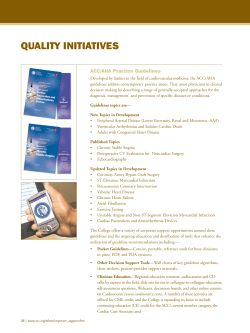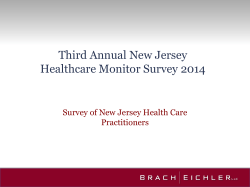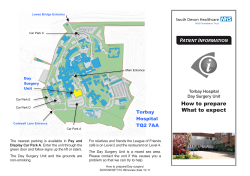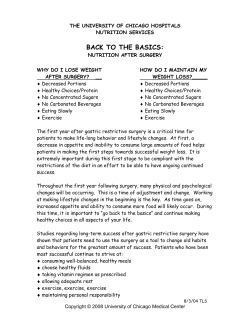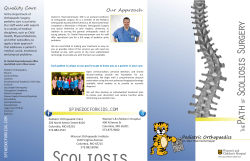
Preoperative Risk Assessment for the Primary Care Physician
Mozow Zuidema, MD, PhD Staff Cardiologist Harry S. Truman Memorial Veterans Hospital No financial disclosures or conflicts of interests How healthy is the patient? How active is the patient? How risky in the planned surgery? Is preoperative cardiac testing necessary? What preventive measures can be taken to reduce cardiac risk? Catecholamine surges Prothrombotic milieu Coronary plaque destabilization Blood loss Volume shifts Classification of Recommendations Class I: Conditions for which there is evidence, general agreement, or both that a given procedure or treatment is useful and effective. Class II: Conditions for which there is conflicting evidence, a divergence of opinion, or both about the usefulness/efficacy of a procedure or treatment Class IIa: Weight of evidence/opinion is in favor of usefulness/efficacy. Class IIb: Usefulness/efficacy is less well established by evidence/opinion. Class III: Conditions for which there is evidence, general agreement, or both that the procedure/treatment is not useful/effective and in some cases may be harmful. Level of Evidence Level of Evidence A: Data derived from multiple randomized clinical trials Level of Evidence B: Data derived from a single randomized trial or nonrandomized studies Level of Evidence C: Consensus opinion of experts Circulation 2006 114: 1761 – 1791. What We Knew Fliesher et al, “ACC/AHA 2007 Guidelines on Perioperative Cardiovascular Evaluation and Care for Noncardiac Surgery.” Circulation. 2007. 116:e418-500. The iPhone debuts…for $599 The final Harry Potter book (Harry Potter and the Deathly Hallows) is released George W Bush was the President The Departed won Best Picture RI PT Figure 1. Stepwise Approach to Perioperative Cardiac Assessment for CAD Fliesher et al. “2014 ACC/AHA Guideline on Perioperative Cardiovascular Evaluation and Management of Patients Undergoing Noncardiac Surgery.” http://content/onlinejacc.org/ AC C EP TE D M AN U SC 2014: Now, with color!!! Step 1: Fliesher et al. “2014 ACC/AHA Guideline on Perioperative Cardiovascular Evaluation and Management of Patients Undergoing Noncardiac Surgery.” http://content/onlinejacc.org/ Emergent Life or limb is threatened if not in operating room within 6 hours Urgent TimeSensitive Elective Life or limb is threatened if not in operating room within 24 hours Delay of 1-6 weeks for further evaluation would negatively affect outcome Delay for up to 1 year Step 2: Fliesher et al. “2014 ACC/AHA Guideline on Perioperative Cardiovascular Evaluation and Management of Patients Undergoing Noncardiac Surgery.” http://content/onlinejacc.org/ Step 3: Fliesher et al. “2014 ACC/AHA Guideline on Perioperative Cardiovascular Evaluation and Management of Patients Undergoing Noncardiac Surgery.” http://content/onlinejacc.org/ Class IIa: A validated risk-prediction tool can be useful in predicting the risk of perioperative MACE in patients undergoing non-cardiac surgery Class III: No benefit For patients with low risk of perioperative MACE, further testing is not recommended before the planned operation RCRI- Revised Cardiac Risk Index American College of Surgeons NSQIP Risk Calculator RCRI • 6 predictors of complications • Major cardiac complications included: • • • • • • Myocardial infarction Ventricular fibrillation Cardiac arrest Complete heart bock Pulmonary edema Revised Cardiac Risk Index 1. History of ischemic heart disease 2. History of congestive heart failure 3. History of cerebrovascular disease (stroke or transient ischemic attack) 4. History of diabetes requiring preoperative insulin use 0-1 predictors = low risk 5. Chronic kidney disease (creatinine > 2 mg/dL) • 2+ = high risk 6. Undergoing suprainguinal vascular, intraperitoneal, or intrathoracic surgery Risk for cardiac death, nonfatal myocardial infarction, and nonfatal cardiac arrest:0 predictors = 0.4%, 1 predictor = 0.9%, 2 predictors = 6.6%, ≥3 predictors = >11% http://www.mdcalc.com/revised-cardiac-risk-index-for-pre-operative-risk/ ACS NSQIP Calculator • 21 predictors of risk for major cardiac complications • NSQIP MICA risk-prediction rule created in 2011 • 525 US hospitals participated • > 1 million operations included • Outperformed RCRI in discriminative power (esp. with vascular) • Calculates risk of: • MACE, death, pneumonia, venous thromboembolism, acute renal failure, return to operating room, unplanned intubation, discharge to rehab/nursing home, surgical infection, urinary tract infection • Predicts length of hospital stay • Limitations: • • • Not validated outside NSQIP ASA status Functional status/dependence http://riskcalculator.facs.org/PatientInfo/PatientInfo RCRI ACS NSQIP Calculator Creatinine > 2 H/o heart failure IDDM Thoracic, Intra-abdominal, or vascular H/o ischemic heart disease H/o CVA or TIA ARF H/o heart failure within 30 days DM RCRI: h/o MI, positive ETT, angina, use of nitrites, EKG with pathologic Q waves NSQIP: MI within 6 months, PCI ever, angina ever, any cardiac surgery (not PPM or ICDs) **CAD itself is not a risk factor CPT code Previous Cardiac event ASA status Age Wound class Ascites Sepsis Ventilator Disseminated cancer Steroid use HTN Previous MI Sex DOE Smoker COPD Dialysis BMI Emergence Step 4: Fliesher et al. “2014 ACC/AHA Guideline on Perioperative Cardiovascular Evaluation and Management of Patients Undergoing Noncardiac Surgery.” http://content/onlinejacc.org/ Step 5: Fliesher et al. “2014 ACC/AHA Guideline on Perioperative Cardiovascular Evaluation and Management of Patients Undergoing Noncardiac Surgery.” http://content/onlinejacc.org/ Step 6: Fliesher et al. “2014 ACC/AHA Guideline on Perioperative Cardiovascular Evaluation and Management of Patients Undergoing Noncardiac Surgery.” http://content/onlinejacc.org/ Step 7: Fliesher et al. “2014 ACC/AHA Guideline on Perioperative Cardiovascular Evaluation and Management of Patients Undergoing Noncardiac Surgery.” http://content/onlinejacc.org/ Low Risk Combined surgical and patient characteristics predict a risk of major adverse cardiac event (MACE) < 1% Ex: Cataracts, plastics High Risk Any procedure with MACE risk > 1% No longer distinguishes between intermediate and high risk because recommendations the same Risk can be lowered by less invasive approach (endovascular AAA) Emergency procedures increase risk Includes ECG: known CAD, significant arrhythmia, PVD, CVD, or other significant structural heart disease, Echo: Assessment of LV function for dyspnea of unknown origin, known CHF with change in clinical status, stable patients with prior LV dysfunction if >1 yr since last EF assessment Exercise Stress Testing for Myocardial Ischemia and Functional Capacity: for patients with elevated risk and unknown or poor (<4 METS) functional capacity if it will change management Pharmacological Stress Testing (MPS/DSE): for patients with elevated risk and poor functional capacity Special Situations If your patient has a resting ECG that impairs diagnostic interpretation during exercise LBBB LV hypertrophy with “strain pattern” Digitalis effect Exercise stress echo or exercise MPI may be appropriate – prefer pharmacologic stress, DSE or pharmacologic stress MPI Pharm stress MPI is suggested for LBBB Borderline or mild reversible perfusion defect? Class I: Revascularization before noncardiac surgery is recommended in circumstances in which revascularization is indicated according to existing CPGs. (Appendix 3) 1. Unprotected Left Main Disease 3 Vessel CAD with or without proximal LAD Disease 2 Vessel Disease with Proximal LAD Disease 1 Vessel Disease with Proximal LAD disease Class III: No Benefit/Harm 1. It is not recommended that routine coronary revascularization be performed before noncardiac surgery to reduce perioperative cardiac events Performing PCI before noncardiac surgery should be limited to: Patients with Left Main disease who can’t get bypass surgery without undue risk Patients with unstable CAD who are candidates for emergent or urgent revascularizations (NSTEMI, STEMI) CARP Trial (Coronary Artery Revascularization Prophylaxis) Showed no difference in perioperative and long term cardiac outcomes with or without preoperative CABG or PCI in patients with CAD Exception: Left Main Disease, LVEF < 20%, Severe AS McFalls EO, Ward HB, Moritz TE, et al. Predictors and outcomes of a perioperative myocardial infarction following elective vascular surgery in patients with documented coronary artery disease: results of the CARP trial. Eur Heart J. 2008;29:394-401. Class I: 1. Elective noncardiac surgery should be delayed: 14 days after balloon angioplasty 30 days after BMS implantation 2. Elective noncardiac surgery should optimally be delayed: 365 days after drug-eluting stent (DES)implantation Class IIa 1. When noncardiac surgery is required: A consensus decision among treating clinicians as to the relative risks of surgery and discontinuation or continuation of antiplatelet therapy can be useful. Bare Metal Stents Drug eluting stents Delay elective Delay elective procedures for at least 1 month and preferably 6 months Restart clopidogrel as soon as possible Consider re-loading dose procedures for 1 year Continue aspirin Restart clopidogrel as soon possible J Am Coll Cardiol. 2014;64(22):e77-e137. doi:10.1016/j.jacc.2014.07.944 Figure Legend: Algorithm for Antiplatelet Management in Patients With PCI and Noncardiac Surgery Colors correspond to the Classes of Recommendations in Table 1. *Assuming patient is currently on DAPT. ASA indicates aspirin; ASAP, as soon as possible; BMS, bare-metal stent; DAPT, dual antiplatelet therapy; DES, drug-eluting stent; and PCI, percutaneous coronary intervention. From: 2014 ACC/AHA Guideline on Perioperative Cardiovascular Evaluation and Management of Copyright © The American College of Cardiology. Patients Undergoing Noncardiac Surgery: Report of the American College of Cardiology/American Heart AllArights reserved. Association Task Force on Practice Guidelines Antithrombotic agents – clopidogrel Bare metal stents vs. drug eluting stents Anticoagulants – warfarin Atrial fibrillation Venous thrombosis Prosthetic heart valves Procedural risk for bleeding Low risk for bleeding Athrocentesis Cataract surgery Dental cleaning / extraction Cutaneous surgery Bridge AF and prosthetic valves AF and significant LV dysfunction (EF<40%) AF and any prior thrombotic event (CVA, TIA, arterial emboli) “high risk” patients No bridging Low risk patients Deep venous thrombosis Pulmonary emboli Hypercoagulable states Factor V Leiden Protein C / S deficiencies Lupus anticoagulant Stop warfarin for 48 hours Start lovenox at 1mg/kg SQ BID for 6 doses Stop lovenox the morning before surgery OR IV heparin until 4 hours prior to surgery Maximize adjuvant medical therapy Aspirin Statin Beta blocker Close perioperative follow-up Prolonged telemetry monitoring, consider ICU monitoring Antibiotics All Prosthetic valves 2. Prior bacterial endocarditis 3. Cyanotic congenital heart disease (CHD) 4. Any repair CHD with prosthetic material * 1. No Antibiotics Uncomplicated valvular heart disease Pacemakers or defibrillators Hypertrophic cardiomyopathy Circulation 2007; 115. Fliesher et al. “2014 ACC/AHA Guideline on Perioperative Cardiovascular Evaluation and Management of Patients Undergoing Noncardiac Surgery.” AC C EP TE D M AN U SC RI PT Figure 1. Stepwise Approach to Perioperative Cardiac Assessment for CAD Colors correspond to the Classes of Recommendations in Table 1.
© Copyright 2025
